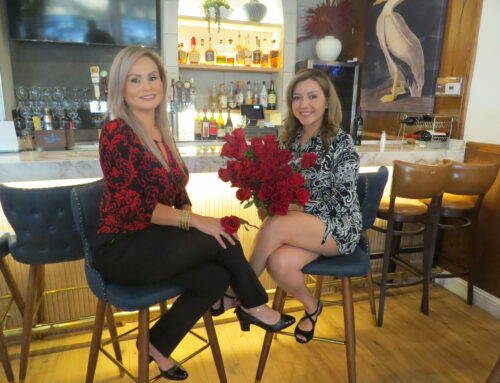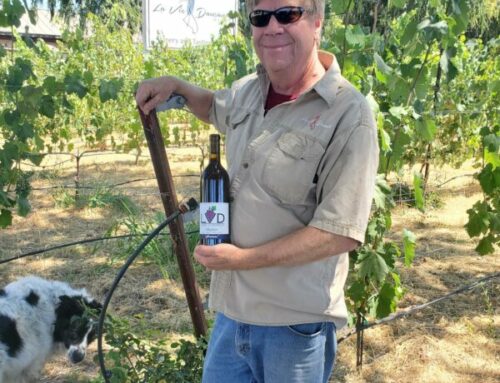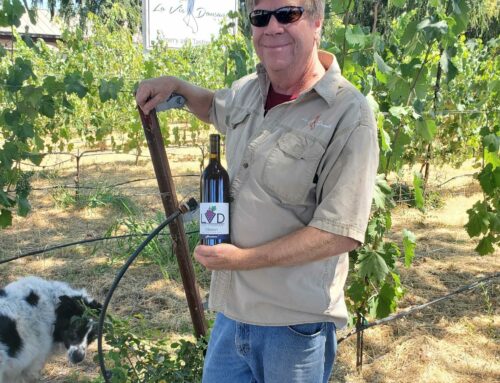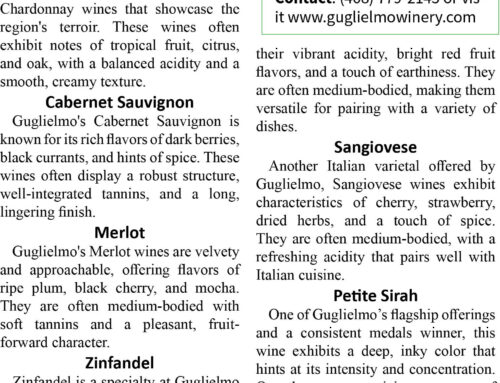Wineries association consider business improvement district funding model
![]()
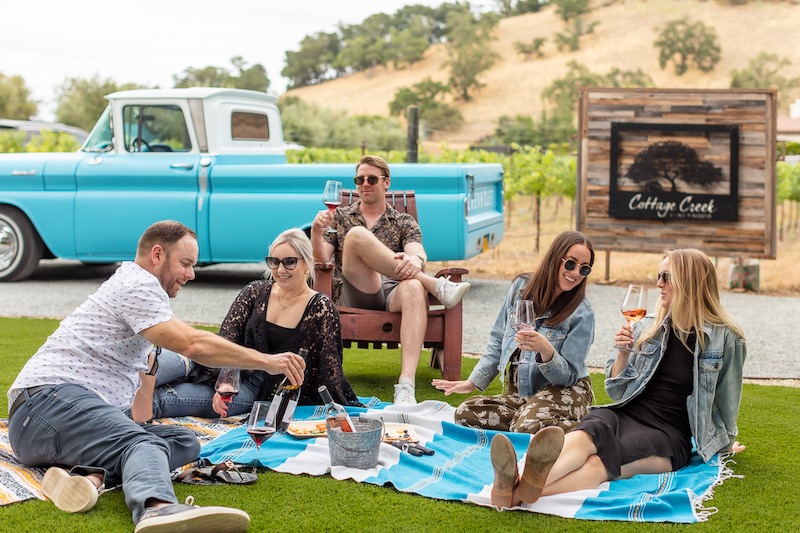
By Marty Cheek
Rich and Rosy Bergin want to give the South Valley a lot of LUV. Their Little Uvas Valley (LUV) winery opened for wine tastings several weeks ago and is bringing in wine fanatics who enjoy vino christened with play-on-word names such as LUV Bug, LUV Potion No. 9, Sea of LUV, and LUV the One You’re With.
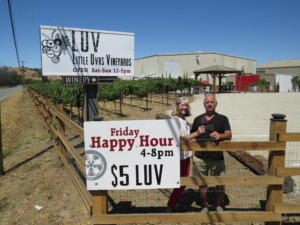
Photo by Marty Cheek Rosy and Rich Bergin in front of their new Little Uvas Vineyard in San Martin.
The couple who have owned Rosy’s at the Beach restaurant in downtown Morgan Hill since 1998 found themselves accidentally getting into the winemaking business. They had purchased a 7.5-acre plot of land in San Martin on Fitzgerald Avenue and needed to figure out what to do with it.
“We’ve been in the restaurant business for 40 years,” Rich said. “We sell a lot of wine, so we put in the grape vines as a means of developing the property. And then the idea of making wine came after that.”
Now lines of vines cover 2.5 acres of the property including 800 Cabernet vines, 400 Merlot vines, 400 Sauvignon Blanc vines, 400 Syrah vines, and 200 Barbera vines. Their first attempt at winemaking was a field blend crushed by George Guglielmo of Guglielmo Winery that was released in 2021 after sitting in barrels for a couple of years. Now they’re sharing with guests their varietals made by award-winning winemaker Alphonse DeRose based in San Benito County’s esteemed Cienega Valley region.
During Wine Week, Rosy hosted a special wine-pairing dinner featuring LUV winery’s varietals at their restaurant. The reception was highly favorable, she said.
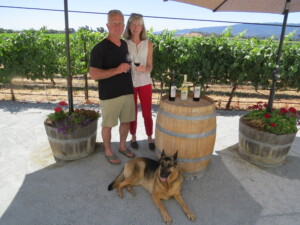
Photo by Marty Cheek Rich and Rosy Bergin, with their dog Zsa Zsa, at their new Little Uvas Vineyard in San Martin.
“Everyone loved the wines. It was a good way to introduce wines to our loyal wine customers at Rosy’s,” she said. “We’re not really using any advertising to connect the two entities (the winery and restaurant). Most people don’t know until they come here and start chatting and then they go, oh, I thought you looked familiar.”
LUV is just the latest of several wineries to open recently in the South Valley.
Gaining popularity is Cottage Creek Vineyard, opened to wine tasting about a year ago and set against the Santa Cruz Mountains on Watsonville Road, a winding country road blessed with many established wineries. Owners Sam and Denise Russell hired master winemaker Chris Graves to produce their collection including Chardonnay, Sauvignon Blanc, Riesling, Pinot Noir, Cabernet Sauvignon, and Syrah.
“When we first started this venture, we kind of doubted ourselves. Will people like what we’ve done?” Denise said. “People love all of our wines. They have gone crazy for them, which has really boosted Sam and my confidence when we are doing the blends. We just trust what we think now and we really seem to hit a home run.”
Winemaker Janu Arasu found an empty retail shop at the Sunsweet Apartments building on downtown Morgan Hill’s Third Street and turned it into the Alara Cellars tasting room. Current releases include Chardonnay, Negrette, Pinot Grigio, Barbera Rose, Cabernet Pfeffer, Grenache, Tempranillo, and Viognier from grapes grown in San Benito County and the Paso Robles region.
 Setting her tasting room downtown instead of at a winery site was a bit of a risk because it’s an unusual business model for the South Valley — although they are common in regions such as Paso Robles and Livermore. The gamble is paying off. Downtown residents as well as visitors exploring the downtown are stopping by for tastings and purchases.
Setting her tasting room downtown instead of at a winery site was a bit of a risk because it’s an unusual business model for the South Valley — although they are common in regions such as Paso Robles and Livermore. The gamble is paying off. Downtown residents as well as visitors exploring the downtown are stopping by for tastings and purchases.
“I think as this region gains more exposure of becoming a more well-known wine region, it would definitely be great to have more downtown tasting rooms,” Arasu said. “It’s kind of the model in a lot of wine regions. “I think I’m the guinea pig. It’s definitely a success.”
Lion Ranch winery owner Kim Engelhardt serves as the president of the Wineries of Santa Clara Valley Association, a local industry group representing about 30 wineries in the South Valley as well as in the northern region of the county. The state of the local wine industry changed a bit with the pandemic when wineries were closed for about eight months in 2020.
“Everything we knew before COVID is now kind of out the window,” she said. “We’re kind of starting from scratch in terms of trends, projections and things we used to rely on such as which weekends are we going to be busy and which ones we aren’t. But the challenges come with a refreshing new start.”
 Many of the association’s wineries had to pivot in their style of customer service. One change was going from a more traditional standing at the bar and chatting with the server throughout the wine tasting to a table service model in which a flight of five or six glasses of wine were served.
Many of the association’s wineries had to pivot in their style of customer service. One change was going from a more traditional standing at the bar and chatting with the server throughout the wine tasting to a table service model in which a flight of five or six glasses of wine were served.
“People are staying longer, so we put in more seating so we can accommodate people staying,” Engelhardt said.
As president of the association, Engelhardt’s main focus is to market out of the South Valley region. She wants to expand the region’s reputation by introducing wine aficionados to the north and the south to the diverse variety of wines available here.
“For people who are in San Jose, there are so many of them still driving out to Napa,” she said. “And that’s ridiculous. We’re so much closer.”
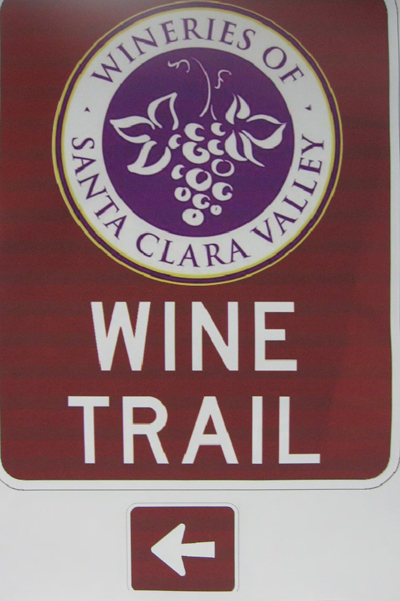
Photo courtesy Santa Clara County
A sample of one of about 70 winery location signs that will be placed on roads throughout the South Valley region, helping people find local wineries.
In October, the association will host a wine pouring event at the historic Mountain Winery in Saratoga. Patrons purchase a ticket to enjoy strolling around the grounds and tasting the wines from association wineries while nibbling on appetizers and enjoying live music and chatting with the winemakers and vineyard owners.
The association is also discussing putting on a special winery mixer targeted at restaurants and bars throughout the county as well as Hollister to encourage them to place local wineries on their wine list.
“That way their customers can try something new and learn about our local wineries and come and visit on the weekends,” Engelhardt said.
Looking out at the local wine industry’s future in the next three to five years, she sees more small, family-owned wineries coming into the South Valley as well as growing the reputation for fine wines.
“We’ll continue to grow in terms of the number of wineries and grow in good scores in rating to help elevate the reputation of the region,” she said.
And the association is exploring long-term stable funding that would allow it to market on the level of the big boys such as Napa Valley and San Luis Obispo, which have international renown for their wine because of intense advertising and promotion.
“Doing anything on a real large-scale marketing campaign is tough for us,” she said, describing the limited money the association has available. “If we can secure the long-term stable funding, we can hire a marketing company that has successful results in the past and be able to slam Silicon Valley with the fact that we’re here and we’re good —and you don’t have to drive any farther than 30 miles to get into good wine country.”
One way the association is looking to achieve this is by establishing a Winery Business Improvement District (WBID), Russell said. This would levy a fee or a tax on its members to pay for marketing and other endeavors that benefit all the members.
A WBID would charge a 1 to 2 percent fee on direct-to-consumer sales and could potentially raise up to $1 million a year to promote the county’s wine industry.
Russell sees a WBID as a “game changer” for the county’s wine industry. Wine regions in California that now use this system include Temecula, Livermore, Paso Robles and Napa.
“I think it’s really important for the future of what we would like to do here,” she said. “And for that kind of marketing that costs a lot of money, I really think it’s necessary. You would have plenty of money to market the area. That money would be used to pay a staff to work on promoting this area and letting everyone know that we’re here.”


